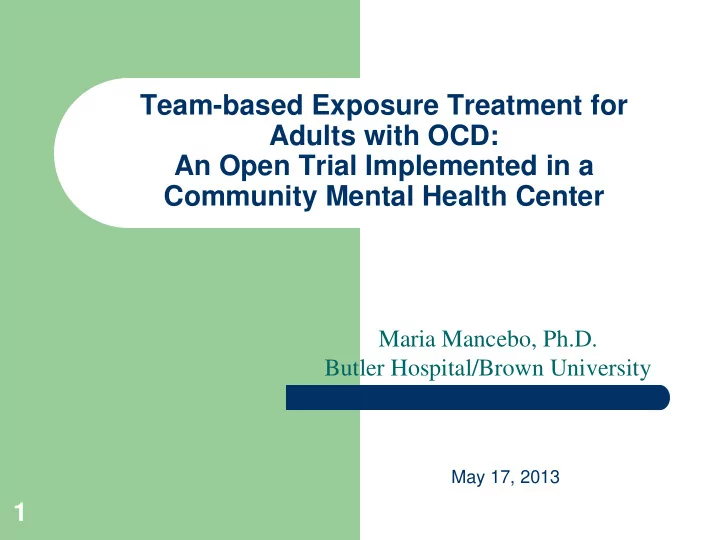

Team-based Exposure Treatment for Adults with OCD: An Open Trial Implemented in a Community Mental Health Center Maria Mancebo, Ph.D. Butler Hospital/Brown University May 17, 2013 1
Background OCD is chronic, often disabling disorder. Exposure-based treatments are most effective psychosocial treatments available for anxiety disorders – 65-85% of treatment completers are very much or much improved – effective with or without concurrent SRI medication Ex/RP is underutilized outside of specialty centers – 25% of patients in OP mental health settings receive min dose – 5% of patients with disabling symptoms receive min dose – Low-income individuals cannot access Ex/RP – CMHCs provide meds and support for the most severe patients 2
Research Aims Adapt Ex/RP for Implementation in CMHC – Qualitative study to determine local barriers and necessary modfications – Develop training program for staff, tx manual, and fidelity measures – Open trial to evaluate feasibility, acceptability and preliminary efficacy of program – Pilot RCT to compare program to standard care 3
Barriers to Ex/RP in CMHC Therapist-level – Lack of training – Large caseloads – difficult to see patients weekly – Low base rate of OCD- few opportunities for Ex/RP – Attitudes towards Ex/RP Patient-level – Fears regarding Ex/RP – Therapy-interfering symptoms – “Incompleteness” symptoms- difficult to tx 4 – Difficulty with Ex/RP in home environment
Modifications to Group Ex/RP Gold Standard Ex/RP Team Ex/RP Modality Individual Group Ex/RP + coaching Frequency Twice-weekly Twice-weekly: grp+coach Session duration 90-120 minutes 60-90 minutes Comorbidity Exclude most SMI SMI stable for 1+ month Therapeutic contact Phone calls, home visit 10 concurrent ind in natural sessions with case environment manager in home 5
Method: Participants Inclusion Criteria – Primary DSM-IV OCD, YBOCS > 16 – Age 18-65 – Low-income – Stable medication regimen for 10 weeks – No previous course of EX/RP Exclusion Criteria – Prominent SI, Mania, SUD, Psychosis in past month – Cognitive Impairment 6
Recruitment Patients: – 12 patients initially screened – 11 met study criteria and enrolled 1 dropped out due to social anxiety re: group1 1 d/c due to hospitalization for medical condition – 9 entered treatment Agency leaders selected staff members – Interest in learning Ex/RP – Likely to be at agency for next two years 7
Staff characteristics: Therapists Age Sex Degree Yrs Yrs Yrs Prev MH Indiv Grp CBT train 55 Fem MA-LMHC 14 5 0 Grad course 38 Fem MA-LMHC 11 7 5 Grad course, DBT trained 30 Fem MSW 6 4 4 Workshop, Intern 8
Staff Characteristics: Case Managers 6 case managers 4 female, 2 male Ages 24-64 (Mn = 38.6+14.6) 5 BA-level and 1 MA-level (theology) Years of providing MH care =6 mos to 30 (Mn=11.0+10) None had formal training in CBT 9
Training Program Two-day training workshop Reading of treatment manual Behavioral rehearsal of key skills “Hands-on” learning experiences Weekly supervision, feedback on taped sessions Self-rated adherence after every session 10
Procedure Treatment – 2 individual pretherapy sessions – 12 weeks of active treatment (group +ind coach) – 2 monthly booster sessions All sessions audio or videotaped Fidelity ratings (Therapist and coach) Weekly team supervision 11
Measures OCD Database SCID-P for DSM-IV Yale Brown Obsessive Compulsive Scale Client Satisfaction Questionnaire Compliance: attendance, hw ratings Patients completed assessments at baseline, midtx, post-tx, 3month fu. 12
Results: Patient Characteristics Mostly white females (n=8) Ages 28-61 (Mn=43.6) Childhood-onset of OCD (Mn=13.6) Single and living alone (n=7) All on disability for psychiatric condition Concurrent Axis I dx (n=8) Comorbid personality disorder (n=8) All on psych meds, 7 on an SRI 13
Results: Client Attendance All a Completers b Treatment Component (n=9) (n=6) Group therapy (12 sessions) Percent of sessions, Range 0-100% 67-100% Percent of sessions, Mean 63% 86% Individual coaching (10 sessions) Percent of sessions, Range 0-100% 40-100% Percent of sessions, Mean 62% 80% a 2 discontinued from tx due to exacerbation of comorbid dx (pre-group, 4 wks) 1 dropped out after four sessions, improved sxs b 1 completed group but felt coaching not necessary 14
Results: Patient Outcomes 15
Results: Client Satisfaction CSQ-8 Range Mean Satisfaction Total Score (4-40) 29-39 35.3 High Group (1-4) 2-4 3.5 High Coaching (1-4) 3-4 3.1 High Helpful for OCD (1-4) 3-4 3.6 High 16
Staff fidelity ratings (Observed) * Mean=90.0% Mean=94.8% 17
Staff Fidelity Ratings (Observed) Coaches – Range 83.8 – 100% – Overall Mean = 92.4% – Coaches found it easier to adhere to Ex/RP with own patients than when new patients – Self-monitoring/feedback helpful “stay on track” 18
Conclusions T-ERP acceptable and feasible for CMHCs More than half improved significantly Staff are trainable and open to fidelity ratings Staff tend to “drift” without monitoring Further Tx Modifications Needed – “Rolling” admission group – Motivational interviewing component – Expand tx to co-occuring anxiety disorders 19
Future Directions Pilot RCT comparing T-ERP to TAU Develop scalable training program and more efficient fidelity monitoring Expand to other anxiety disorders Identify cost-effective methods of improving patient adherence 20
Recommend
More recommend